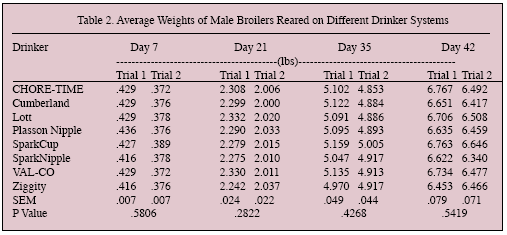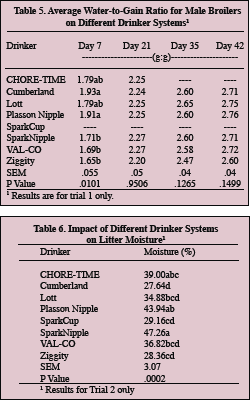



Evaluation of Nipple Drinkers and the Lott System for Determining Appropriate Water Flow for Broilers
By J.M. Cornelison, A.G. Hancock, A.G. Williams, L.B. Davis, N.L. Allen and S.E. Watkins and published by the University of Arkansas's Avian Advice - Unexplainable poor performance can occur from time to time. While production problems can originate from innumerable sources, some common situations should not be overlooked. When management factors are good and birds still perform poorly, it may be time to take a closer look at the feed bins and pans to determine if mold growth is the source of the problem.| The Author | |
 Dr. Susan Watkins Extension Poultry Specialist |
|
Introduction
Water is thought by many to be the most important nutrient for poultry. Charles H. Goan summed up the true concerns of the broiler industry when he stated, “The purpose of any broiler watering system is to provide sufficient water for optimum bird growth and efficiency.” In recent years the industry has abandoned v-troughs, cups, and bell type drinkers in favor of nipple water systems. Nipple watering systems are advantageous because they improve water quality, eliminate the daily cleaning chores, and reduce spillage. Reduced water spillage creates dryer litter, decreases ammonia volatilization and reduces plant condemnations from breast blisters. Although, it is clear that nipple waterers are efficient, questions remain about proper management and drinker function.
It is important to realize that no two watering systems are identical. Numerous design differences exist, which dictate how each system must be managed with respect to water pressure (entering the regulator), waterline height, bird/nipple density, and flow rate or water column height. Thus, proper drinker management must be utilized for each system to achieve maximum bird performance.
Lott and coworkers used static flow measurements to generate guidelines designed to determine adequate nipple drinker flow. Static flow (milliliters of water delivered per minute) is measurement by triggering the nipple and timing the collection process for one minute. The “Lott flow method” uses the formula (Weeks of Age)* 7 + 20 to calculate necessary weekly static flow. However, this guideline creates several difficulties. First, it is important to realize that static flow measurements only provide an indication of how much water can flow, not how much water the bird consumes.
For some drinker types the bird activates the nipple using a side to side action, not the straight up and down motion measured by static flow. Also, the bird uses quick pecking motions to obtain a drink as compared to the constant pressure used to trigger the pin in static flow measurements. Second, low flow drinking systems are designed differently than other systems and cannot achieve Lott’s suggested guidelines. This discrepancy has created confusion regarding whether or not low flow systems deliver adequate water to the birds and concerns about poor bird performance due to drinker selection. With this in mind, two trials were conducted to evaluate broiler performance using different drinker systems managed according to manufacturers operating procedures. The trials were designed to determine if the Lott flow formula is an appropriate method for evaluation of all drinker types. A second objective was to determine if all drinker systems tested supported similar bird performance.
Materials and Methods
The following seven drinkers were evaluated during these trials: CHORE-TIME® RELIA-FLOW™, Cumberland Nipple Drinking System, Plasson Nipple Drinker Line, Roxell SparkCup, Roxell SparkNipple, VAL-CO, and Ziggity Max3. Each was compared to a Val-Roaster drinker maintained according to the Lott requirements. The Roxell SparkCup drinking system was installed with two cups per pen.
Trial One
One thousand two hundred and eighty (1280) male boiler chicks (day-old) were randomly placed in 32 floor pens, allocating 40 birds/pen (1.25 sq. ft.) and 7 birds/nipple. There were four replication pens per drinker system. Water was supplied to each line via a plastic water tube feeding from two 5-gallon buckets that were elevated about four feet above the water line. All drinkers were managed according to manufacturers’ recommendations and static flow was measured weekly. In the first trial, each nipple drinker line with the exception of the Plasson systems were equipped with regulators to maintain pressure rates. Individual bird weights, feed consumption and water usage were measured on days 0, 7, 21, 35, and 42. The weight of all birds that died or were culled was recorded by pen and this weight was used to adjust feed conversion.
Trial Two
Two thousand two hundred (2200) male broiler chicks (day old) were randomly placed in 40 floor pens, allocating 55 birds/pen (.90 sq. ft.) and 9 birds/nipple. There were five replicate pens per drinker system. Water was supplied to each water line via the house main. In this trial, the Plasson drinkers were equipped with regulators. The flows for all drinkers were managed according to manufacturers’ recommendations. However, for this trial the static flow was measured each time the line was adjusted instead of once a week. Pen weights of birds and feed consumption were measured on days 0, 7, 21, 35, and 42. Litter moisture was measured using a 250-gram sample collected from four locations directly under the water lines on day 42. The weight of all birds that died or were culled was recorded by pen and this weight was used to adjust feed conversion.
Nutrition and Management
Birds were fed diets formulated to meet the Cobb-Vantress nutrient recommendations. The starter diet was fed from 0 to 14 days, grower diet from 14 to 28, finisher I from 28 to 35 and finisher II from 35 to 49 days. The starter diet was fed as a crumble while the grower and finisher diets were fed in the pellet form. Diets were supplemented with Coban 60 and BMD at 1.5 and 1 pound per ton, respectively. Birds were reared under a ventilation and temperature regime reflecting industry standards. The lighting program was 23 hours of light/day for the first four days followed by natural day length to 13 days of age and then birds were placed on 6 hours of darkness per day. The daily high-low temperatures were recorded. All birds received Fayetteville city water.
Results
The average weekly static flow measurements for each of the drinker systems are shown in Table 1. For all the drinkers except the Ziggity Max3, the flows were similar for both trials. In the first tiral, the Ziggity Max3 was kept at a static flow
of 10 ml/minute for the first four weeks. In the second trial the flow for this drinker was 10, 15, 20 and 27 ml/minute for weeks 1, 2, 3 and 4, respectively. Static flow could not be measured for the SparkCup line, because this line was a cup system.

The data indicate that the drinkers managed according to the Lott flow guidelines were maintained almost exactly according to the recommendations. While statistically significant differences were found in static flows, only the Roxell SparkNipple produced higher static flow than the Lott recommendations. Yet no statistical differences were seen for body weights at any of the periods measured (Table 2).

Though not significant, in trial one on day 42 broilers reared on Ziggity Max3 drinkers weighed slightly less than birds on other systems. This reduction in weight was because the drinker was managed at very low static flows (less than 10 ml/minute) for the first four weeks. It is important to note that the body weights of broilers reared on the Ziggity Max3 in the second trial were similar to the weights of broilers reared on the other drinker systems. This result provides a strong case against limiting drinker flow and demonstrates that only a slight increase or decrease in flow rates can have a significant impact on bird performance. No statistical differences were seen between drinker types with respect to feed conversion or overall mortality (Tables 3 and 4).


However, this trend did not continue and there were no statistical differences in consumption among the different lines for the remainder of the trial. Water consumption could not be measured on the SparkCup drinker, because the line requires high water pressure entering the regulator to operate properly. Also, water pressure entering the regulator for the CHORE-TIME line could not be maintained once the birds were four weeks old. At this time, the line was connected to the house main.
Litter moisture values obtained from samples collected under each drinker line are shown in Table 6. Highest moistures were obtained from litter collected beneath SparkNipples, while lowest values were found under the Cumberland system. It is important to note that the litter samples were collected from directly underneath each drinker line, thus the amount of moisture was not representative of the entire pen.
Conclusion
During the two trials, broiler performance was evaluated on 8 drinker lines managed according to manufactures operating procedure. The trials confirm that no two drinker systems are managed the same and that proper management of watering systems is essential for maximum broiler performance.
The trials indicate that static flow rates vary significantly among the different lines tested. In addition, the results indicate that while helpful, the Lott flow formula isn’t necessarily the best tool for managing the flow on all drinkers. On the other hand, measuring static flow of drinkers can help to identify inconsistencies in watering systems both within a farm, within a house and even within a line. Thus, static flow measurements are valuable tools when used correctly. However, it is most important to know and follow the manufacturer’s recommendations for the particular drinker system for optimum results.

Source: Avian Advice - Fall 2005 - Volume 7, Number 3









